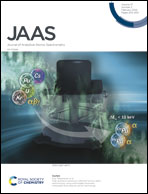Results report of apatite fission-track analysis by LA-ICP-MS and its comparison with the conventional external detector method of dating†
Abstract
This work presents the apatite fission track (AFT) age and multielement analysis of four samples performed by laser ablation-inductively coupled plasma-mass spectrometry (LA-ICP-MS). The central ages calculated range between 15.4 and 196.9 Ma and are in good agreement with the central ages obtained previously by the external detector method (EDM); the precision improved when U-poor samples were dated as well. The concordance correlation coefficient of the uranium content measured in the same grains by both methods indicates a high degree of agreement. The boustrophedon pattern of ablation produced an ablation depth of around 1.5 μm, and allowed, by meticulous observation of the mass spectra, the presence of uranium zoning to be deduced and differentiated. Compositional results obtained during the acquisition of LA-ICP-MS data are also presented, enabling the determination of the source lithology, making possible more specific provenance determinations. These results validate the procedure used in the first Argentine geochronology laboratory, La. Te. Andes S.A., and allow this methodology to be used routinely in apatite samples.



 Please wait while we load your content...
Please wait while we load your content...